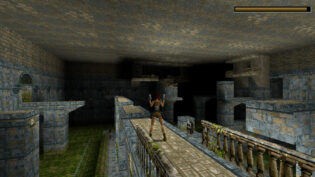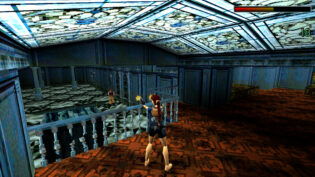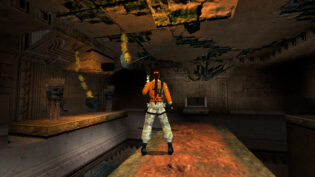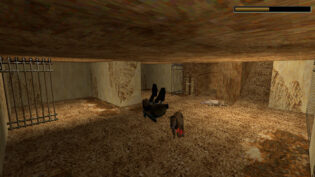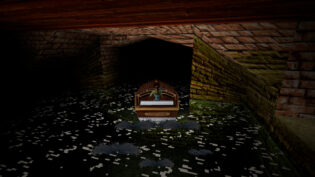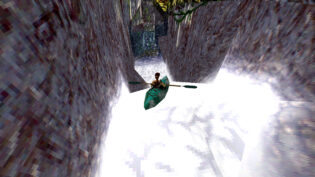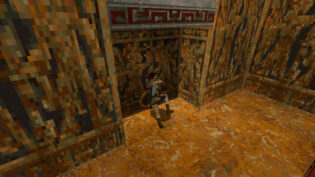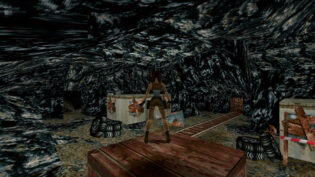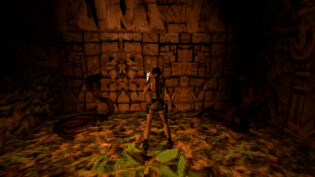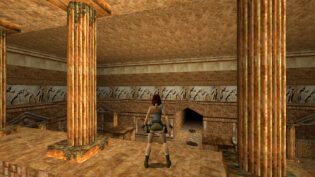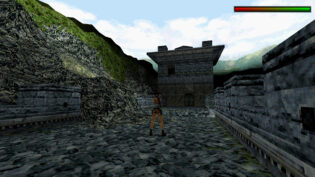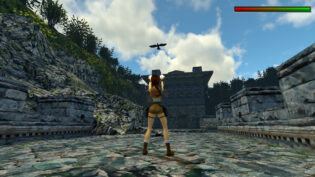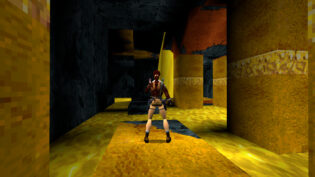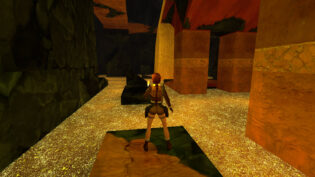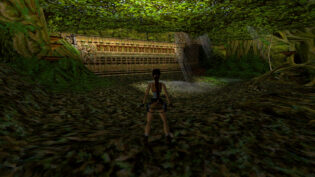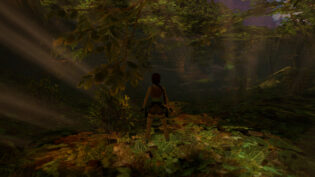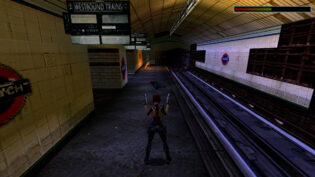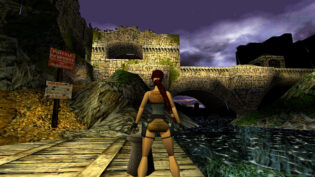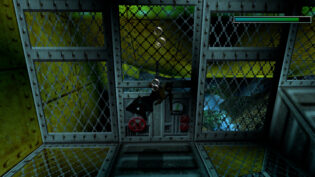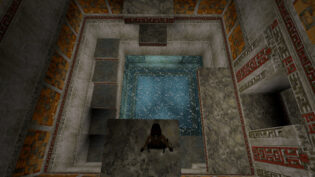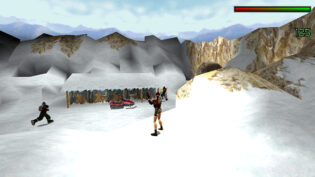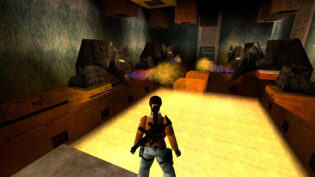O tempora is a series of retrospective posts where I play games from ages before to see if they stood the test of time.
I’ve been meaning to replay the classic Tomb Raider games for years now. I could – I own the PC versions on GOG and while there are some nuances about running them on modern systems, those ports are solid. But I never had time or desire, as all Tomb Raider games are quite long and slow. I used to love The Last Revelation and quite enjoyed most of Chronicles and played them a lot as a teen. But the first three? I’ve never properly finished the first, stopped playing the second at around midpoint and remembered next to nothing about the third, despite completing it decades ago. There were also three PC exclusive expansions – Unfinished Business, Golden Mask and The Lost Artefact for the 1st, 2nd and 3rd games respectively that I never even saw.
With the release of Tomb Raider I-III Remastered (Starring Lara Croft), I couldn’t delay this any further. A definitive package of the three games I was least familiar with, with the mentioned expansions and a bunch of quality of life and visual upgrades? Sign me up. A entire month of playing them later I can finally share what I think of the collection and the games themselves.
I’m sure you’re already familiar with what Tomb Raider is as a franchise. A series of action adventure titles following the adventures of Lara Croft, who loves to get into strange situations and explore different real and completely fictional locations, avoid death traps and find ancient artefacts. Clearly inspired by the Indiana Jones movies and the original two Prince of Persia games, the first TR was instrumental in shaping the fully 3D action adventures with platforming to come. Tank controls, precise movement, ability to judge every jump and every surface at a glance and calculate the path through the little obstacle course prepared by the developers – just like Prince of Persia, but in a fully 3D space. And whenever you love or hate the slowness and precision required from the player, as a mistake can easily lead to death, you can’t deny that platforming in these games felt exhilarating and meaningful. You weren’t just pushing a directional button to move vertically, you were making life or death choices with every button you press, hold or stop holding.
And, really, the original game nailed what it wanted to do, setting the baseline for the 4 following games. The arsenal of moves expanded, new gimmicks and ideas were introduced with every game while visuals improved, but all of the core mechanics were there since the beginning. Overall, the Core Design timeline of Tomb Raider could be tentatively divided into 3 “periods” based on some of the underlying engine features. Period 1 would encompass the first three games, TLR and Chronicles form the second and The Angel of Darkness the last. The first period had similar design for the menus, items could only be used from the inventory, all characters talked by bobbing their heads with no lip animations and in all three titles the tutorial was a separate level that got expanded with secrets and fun little interactions with each next game. As Eidos Interactive (now the European office of Square Enix) pushed for annual releases of the franchise, it did affect the quality of games and I would argue that only the original and The Last Revelation feel like titles made with clear vision and up to a high quality standard, while the rest of the releases suffered from not having enough time to cook. Infamously ending with The Angel of Darkness being pushed to release in a completely unfinished state and the demise of Core Design.
So what does Tomb Raider I-III Remastered as a collection bring? First three titles and the previously PC only expansions are packaged as one game. The visual presentation of each title in the original mode is attempting to show the games similarly to how they originally looked on Playstation 1 (including the framerate) but running on modern higher resolutions. On top of that, with a push of a button you can switch to the updated visuals for each game that keep the base geometry and models the same, but add a lot of small details, high resolution textures and turns some sprite objects into 3D models. The “readability” of the games with this visual change is not seriously affected and occasionally levels can be even easier to analyze. Judging by my screenshots, you’ll see that I played the games in the original mode as I simply prefer that look, but I have to admit that there are moments where the new visuals are fantastic.
Lara still can’t sprint or crouch until TRIII, but minor updates to existing mechanics and moves were done to make all games feel more consistent. For example, you can perform turns during jumps and swimming or safely walk through floor spikes in the first game, and the way some moves are done and how responsive they are is unified across the entire collection. Interestingly, some cool quality of life additions are also brought in. Every weapon and flares now have a shortcut on both controller and keyboard (hold inventory button and press face or shoulder buttons), although save/load and health pack hotkeys remains exclusive to the keyboard. Right stick can now be used to pan the camera without going into the Look mode. And in TRIII the previously cut feature of rolling when you crouch was implemented. That said, I’ve also noticed that controller responsiveness for jumping is different in comparison to the PS1 versions, where you could press jump and direction at the same time and consistently get the result you expect, whereas in this version Lara may ignore one of the inputs instead.
On top of updating classic tank controls, the game also introduced camera-relative controls. And I… don’t think anyone not familiar with the games should play with them. They do have some cool stuff and even introduce the quick drop-down move from The Angel of Darkness and speedrunners already found a faster way to play the game with them. But for first casual play, the game will probably feel too unpredictable and inconsistent without tank controls it was designed for. Sadly this remaster didn’t go the Capcom route with “modern controls” from Resident Evil/Zero HD, so you can’t have the analogue stick doing new controls while the d-pad does the tank controls.
There are other good and odd changes. On one hand, I was very surprised to hear a music track that didn’t get into TRIII originally (and was reused in a new arrangement in TLR instead) in the collection. On the other – the soundtrack for the games was not made available separately, even though the music files are easily accessible in the folder. There’s no included manual for the games either, which is especially bizarre for the expansions where the entire story is only explained in said manual. But even apart from the story, there are plenty of interactions and button presses that the game never explains to you and that are not found in the settings, like the controls for vehicles. None of the already mentioned shortcuts are explained or shown anywhere too.
In fact, you can’t even change video settings for the collection. Game selects a resolution and refresh rate based on your desktop and you can’t do anything about it. Brightness change would’ve been welcome too, since TRII and especially III get extremely dark in some scenes and while in some situations that’s intentional and motivates you to use flares, in some you don’t have access to flares and can’t see anything. Which was not the case with older PC ports of the games and wasn’t as much of a problem on PS1, as you were probably used to changing the brightness of your TV quite often anyway. The sound mixing of TRIII is much quieter than the first two games for some reason. There are occasional visual bugs that make some objects next to impossible to see in one or both of the visual modes. And I’m pretty sure there’s chromatic aberration in the textures of TRIII that I don’t think exists in the original PS1 release.
Some things are quite dumb. Achievements are insanely stupid, as there are hundreds of them and some require you to play the game incorrectly. There’s a “new game +” mode that’s utterly pointless. On top of giving you all weapons (but not a lot of ammo and other resources) from the start it changes how often you can save the game for the first and third game to work like it used to be in the PS1 releases. But since the second game worked the same on PC and PS1, it seemingly barely changes anything and on top of that I just don’t recommend playing with the limited save functionality. It feels as if the developers considered having a proper chapter select like what Crystal Dynamics did in the Legend timeline, but didn’t or couldn’t add it. And now that I mentioned them, why is Kain’s portrait from Legacy of Kain present in the updated visuals mode of Lara’s manor? Crystal Dynamics added it in Legend as an easter egg to their other franchise, but they had no involvement with the original TRI-III nor this remaster.
Who had highly questionable involvement, are Saber Interactive and several other Russian-based tax paying contractors. Yes, if you didn’t know, while Saber are legally a US-based company, their main workforce office is in Russia. And sure, Saber are known for their remaster work and some of the said contractors worked on a highly respected modern engine port of the classic TR titles that might’ve served as a basis for this collection. But Aspyr Media went so far as to also add Russian voice acting to these games (that never had it originally), increasing the number of said Russian-based tax paying contractors. And on top of that allowed the contracted Russian translator to create Ukrainian localisation, that seems to be at the quality lower than that of a machine translated text. In other words, Aspyr went out of their way to (allegedly) pay money to (allegedly) tax payers from Russia who’s tax money will be spent on bombing Syria and Ukraine. And who can tell if the Ukrainian localization was done poorly out of laziness or out of spite? Was all this really necessary Aspyr? I doubt purchasing the game at this point changes anything, but could we get the other classic Tomb Raider games remastered without potentially sponsoring war crimes along the way?
With the long talk about the collection out of the way, let’s talk about the games themselves. After all, there’s no point in a remaster, if the game is not worth playing, right?
While the original Tomb Raider is a bit simpler than the two sequels that followed, it also feels like the most competent and thought out. There’s a clear vision of what the adventure should be about, the story, for how simple it is, gives it direction from start to finish, while the level design and puzzles in general still feel very good. The combat for the first third of the game is really well balanced and even by the end, when it starts getting annoying, it remains relatively well designed. And it’s also interesting that most of the time Lara has to fight animals or strange creatures with humans being almost exclusively boss fights. The music plays rarely, but when it does it’s wonderful. With the more responsive controls of this remastered collection the game feels just a bit faster and more fun. But, really, even in its original form it’s very good.
What a lot of people might ponder is – with Tomb Raider: Anniversary existing and being one of the best entries in the series at that, is there even a point in playing the original game? And… yeah, I don’t have a good answer. Original TR feels dated in a lot of regards, but then Anniversary has some poor design choices that didn’t age well either. In general, I’d say that if you love the very methodic and thoughtful approach to platforming original Tomb Raider games had, replaying the first Tomb Raider in 2024 will still feel good. But if you wish things to be a bit faster but also more complex, Anniversary might be a clear winner for you. I still enjoyed the game, even if for myself the choice is clear – I’d rather replay TR:A in the future.
Speaking of choices – Unfinished Business is a horrible one. There’s nothing positive I can say about this collection of 4 additional levels to the original Tomb Raider. Everything about its design is disgusting and playing these levels is just frustrating. Avoid it if you value your sanity.
The first proper sequel of the game marked a noticeable change in direction. For one, Eidos decided to market even heavier into Lara, starting with the title of the game – Tomb Raider II Starring Lara Croft. She was featured in lots of “sexy” ads, the game itself ends on Lara going to into a shower, but her character is basically entirely blank in comparison to the first game. Another change was a much increased emphasis on action and humans are now the most common enemy type. After the first level, that feels like an evolution of the first game with a few new moves and abilities added, the game switches into an action movie mode, where instead of exploring ancient ruins you start fighting mafia in Venice. The game does return back to the ruins eventually and has some neat locations, but the tone is nonetheless permanently shifted into the “cool” and “cinematic” sequences and a few (frustrating to control) vehicles are added into the set of mechanics available to Lara for the first time.
As mentioned, I never finished this game because despite its immense popularity, I found it frustrating. Yet that frustration doesn’t really start properly until the second half of the game and especially in the final locations, where the game becomes almost as bad as Unfinished Business. Extremely finicky moves, cheap traps, unfair deaths and way too much action. Even the enemies spawn blatantly on camera out of thin air as if the developers stopped caring. Also the change in how secrets are now special items that do not reward you with a “proper” reward unless you find all 3 of them ends up being more frustrating than fun, although secrets design itself this time feels more refined and I’ve managed to find most of the secrets in the game. Overall, TRII feels messy – lots of interesting improvements wrapped in a lot of tedious action and frustrating set pieces. It does start well, but I’m also glad to finally get it out of the way as I doubt I would want to play it ever again.
Interestingly, its expansion Golden Mask at times feels better than TRII. But only occasionally, as it has a set of issues of its own. It’s ambitious, has lots of unique visuals, some of which look beautiful (and are incredible with updated visuals) and its levels are impressively dense and layered on top of itself. Sadly, this layering often becomes too complex for its own good and the issues with terrible enemy spawns from the main game continue. Still, this expansion is worth playing, maybe even more so than TRII.
Experimentation of the Golden Mask and lessons from TRII lead to a rather curious next entry – Tomb Raider III: Adventures of Lara Croft. This game tried to experiment with a lot of great ideas. The main sections/world locations can be done in any order, apart from the first and last ones. Several levels feature different paths through them, often mutually exclusive. Levels in general are very dense and a lot of the secrets (that are back to being helpful loot) are quite involved, requiring complex actions and long backtracking. Visually the game was also heavily updated and now had lots of coloured lighting and very high contrast and punchy scenes. In fact, I would argue that the original visuals for this particular game look much better in most cases to the updated ones of the remaster. There are lots of new vehicles, all of which do their own unique thing and their controls were updated to work closer to the typical racing games of the era. And sometimes there are mechanics and ideas that are rarely used, like the mud that you can drown in or cold water, swimming in which adds temperature on top of air to look out for. Or the very rare poison/venom that must be healed with health packs.
Yet, for every spark of brilliance, there are giant blobs of frustrations with how every idea is implemented. Levels are often nonsensically complex and present many paths and many tools at once without even giving you a clear goal. The plot is just a collection of barely related vignettes, as if five separate scripts had their pages torn out and then remaining pages were put together haphazardly. The scenarios are also stupid beyond belief, much dumber and more outrageous than anything that happened in the franchise before. How do you feel about visiting Area 51, murdering its personnel and finding the aliens? Tomb Raider III is straight up exhausting, in ways that the first two games never become. Given how many awesome ideas are in this game, it’s a horrible shame that the end result feels so obnoxiously unfun as a whole. It’s still worth experiencing, if I’m honest, but I don’t recommend finishing it if you feel like it’s getting on your nerves.
Instead, you could play The Lost Artefact. It’s not as inventive as Golden Mask was, but it feels like a far better use of mechanics and ideas of the TRIII than the TRIII itself. The plot is even dumber than before, as you can find an army of angry Scots in traditional clothing or indiscriminately murder the workers of the English Channel, but at least this time its trying to have fun with itself and use these elements creatively. Plus it focuses almost entirely on exploring the locations in the British Isles, which is refreshing. It still suffers from some of the issues as the TRIII, like some level design being too confusing, but because of its rather short length and less frustrating aspects, I liked playing through the expansion.
So, apart from some weird design and business decisions, the main attraction of this collection is really the very first game. It’s still worth playing the rest of the titles and expansions (apart from Unfinished Business, spare yourselves that), but nothing ever reaches that clear vision that the original game had. I hope all of the main collection issues and lack of some elements will get fixed with updates and we will get The Last Revelation paired with Chronicles next, hopefully with smarter business decisions along the way. And also hope that newer players will get to experience what Tomb Raider was about and get inspired to make action adventures with platforming that feels like a meaningful interaction and not just something to “slow the pace” or “bring variety”.


